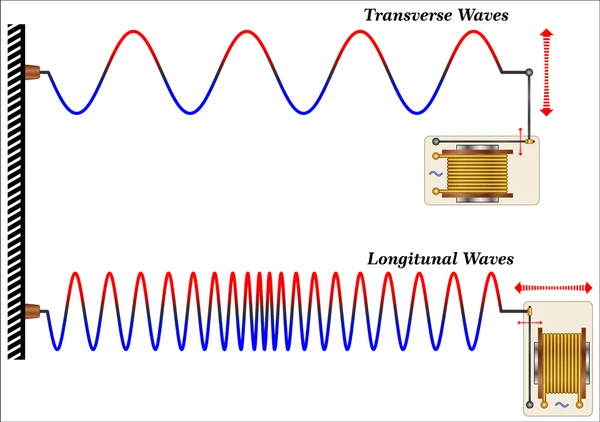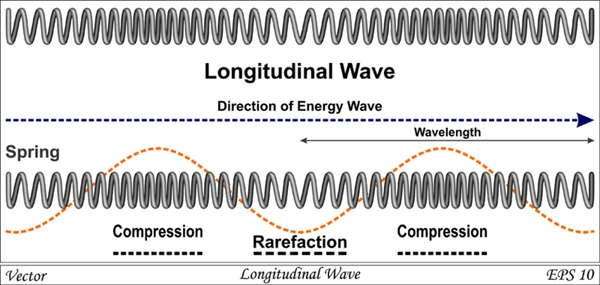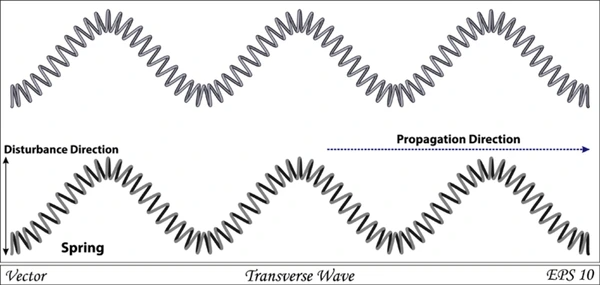
What Are Mechanical Waves?
Mechanical waves are a key concept in physics, describing waves that need a physical medium to travel. These waves transfer energy by causing particles in solids, liquids, or gases to vibrate or oscillate. From the sound we hear to the ripples on water, mechanical waves are all around us, showcasing how energy moves through different materials. This article delves into the basics of mechanical waves, their types, and the principles that govern their behavior.
Types of Mechanical Waves: Transverse and Longitudinal

Longitudinal Waves
- Particle Movement: Particles move parallel to the wave’s direction of propagation, creating compressions and rarefactions.
- Key Characteristics:
- Compressions occur when particles are pushed together.
- Rarefactions happen when particles are pulled apart.
- Examples: Sound waves traveling through air, water, or solids demonstrate this type of wave.
- Speed of Sound: The speed depends on the medium’s elastic properties and density.
Transverse Waves
- Particle Movement: Particles move perpendicular to the wave’s direction of travel.
- Key Characteristics:
- The particles exhibit up-and-down or side-to-side motion.
- Examples: Waves on a string, where vibrations occur perpendicular to the string’s length, showcase transverse motion.
Frequency-Based Classification of Mechanical Waves
Ultrasonic Waves
- Frequency Range: Above 20 kHz, exceeding the upper limit of human hearing.
- Applications:
- Used in medical imaging, such as ultrasound, for visualizing internal organs and tissues.
Infrasonic Waves
- Frequency Range: Below 20 Hz, lower than the human hearing threshold.
- Applications:
- Commonly employed in geophysical exploration and weather prediction due to their ability to penetrate vast distances.
Differences Between Mechanical and Electromagnetic Waves

Nature and Composition
- Mechanical Waves: These waves require a physical medium, such as air, water, or solids, to propagate. They arise from particle vibrations and are categorized into:
- Longitudinal Waves: Particles move parallel to the wave’s direction.
- Transverse Waves: Particles move perpendicular to the wave’s direction.
- Electromagnetic Waves: These waves do not need a medium and can travel through a vacuum. They consist of oscillating electric and magnetic fields and include types like radio waves, visible light, and X-rays.
Propagation and Medium
- Mechanical Waves: Energy transfer occurs via particle vibrations in the medium. For example, sound waves propagate through air by vibrating air molecules.
- Electromagnetic Waves: These waves move independently of a medium, propagating through a vacuum with oscillating electric and magnetic fields.
Speed of Propagation
- Mechanical Waves: Speed varies based on the medium’s properties. Sound, for instance, travels faster in solids than in liquids or gases.
- Electromagnetic Waves: These waves always move at the speed of light in a vacuum, approximately 3 x 10^8 meters per second.
Interaction with Matter
- Mechanical Waves: These waves can be absorbed, reflected, or transmitted. Sound waves, for example, are absorbed by foam and reflected by hard surfaces.
- Electromagnetic Waves: Their interaction with matter depends on frequency and material properties. Radio waves pass through buildings, while X-rays are absorbed by dense materials like bones.
Applications
- Mechanical Waves: Widely used in sound communication, ultrasound imaging, and seismic exploration.
- Electromagnetic Waves: Essential for applications such as broadcasting, medical imaging (MRIs and X-rays), and microwave energy transmission.
Applications of Mechanical Waves in Everyday Life

Communication Systems
Sound waves play a vital role in communication technologies, enabling devices like radios and smartphones to transmit and receive audio. These systems convert electrical signals into audible sound, ensuring seamless communication.
Medical Imaging
Ultrasound technology uses high-frequency sound waves to produce detailed images of internal organs and tissues. By analyzing the reflected waves, doctors can diagnose conditions and plan effective treatments.
Music and Entertainment
Musical instruments create vibrations that generate sound waves, which our ears perceive as music. Instruments like guitars, drums, and pianos rely on this principle, enriching our entertainment experiences.
Navigation and Location Services
Sonar systems utilize sound to detect objects and navigate underwater. This technology supports marine navigation, fishing, and even ground-penetrating radar applications for land-based uses.
Industrial Applications
Ultrasonic cleaning systems remove dirt and contaminants efficiently using high-frequency waves. Industries such as electronics and medical device manufacturing rely on these systems for precision and cleanliness.
Energy Transmission
In power plants, vibrations help convert and transfer energy efficiently. These waves enhance energy processes, ensuring reliable electricity distribution.
To get detailed scientific explanations of mechanical waves, try Patsnap Eureka.

